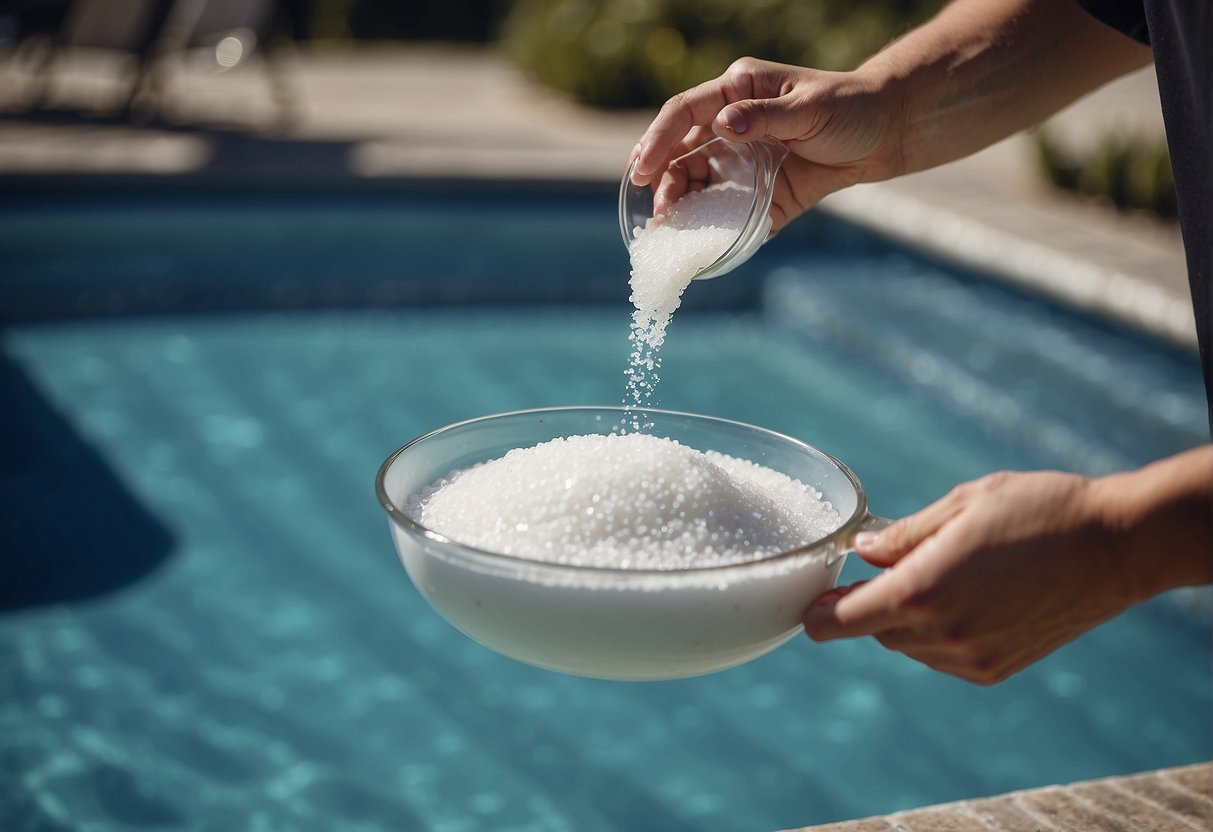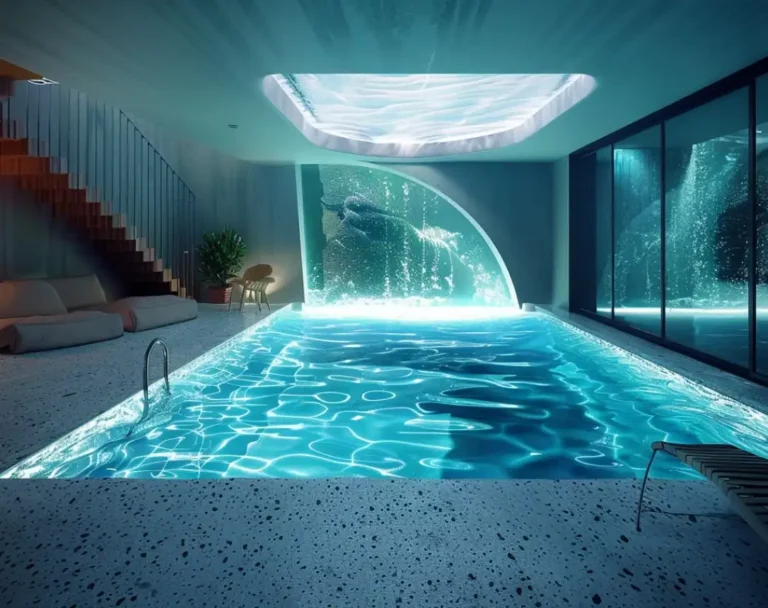Maintain the perfect pool with “How Much Salt to Add to a Swimming Pool: Insider Tricks,” where we demystify the science of salinity for your backyard oasis. Get the scoop on the ideal salt levels to keep your water crystal clear and swimmer-friendly all year round.
What is Pool Salinity?
Salinity is key to ensuring your swimming pool is a refreshing oasis, and understanding it is crucial for proper pool maintenance. It’s the balance of salt that keeps your water clean and your swims enjoyable!
Salt and Its Role in Your Swimming Pool
Salt in your swimming pool isn’t just to give it that ocean-like feel; it’s actually there to generate chlorine. When you add salt to the pool, a special device called a salt chlorine generator breaks it down through a process called electrolysis. This process turns salt into chlorine, which is essential for keeping your pool free of algae and bacteria. You’ll need a good quality testing kit or salt test strips to measure the salt level so that your generator can work its magic!
Ideal Salt Levels for Pool Health
For the health of your pool, the ideal salinity level is typically around 3,200 parts per million (ppm). While anywhere between 2,700 and 3,400 ppm can be acceptable, it’s crucial to aim for this sweet spot. Too low, and your generator might not be able to produce enough chlorine. Too high, and you could start to see corrosion on pool components. Remember, periodic testing is a must!
- Ideal range: 2,700 – 3,400 ppm
- Optimal target: 3,200 ppm
Effects of Salinity on Pool Maintenance
Correct salinity levels not only ensure your pool stays clean, but they also affect overall maintenance. If your levels are too low, your pool might turn into a breeding ground for unwelcome guests like algae. If they’re too high, the water can damage pool fixtures and leave behind salty residues.
As a smart pool owner, you should check your pool’s salinity regularly with a reliable test kit. Regular checks mean you’ll have less fluctuations to deal with, simplifying your salt water pool maintenance routine. Keep those levels checked and balanced, and you’ll be on your way to endless, carefree swims!
How Much Salt to Add to a Swimming Pool? Calculating Pool Salt Levels

Determining Your Pool’s Current Salinity
Before you can add salt to your pool, you must first determine the current salt concentration. You can perform this test using a digital tester or test strips, both of which are readily available at pool supply stores. Ideally, the salt levels in a saltwater pool should be between 2,700 to 3,400 ppm (parts per million).
Formula for Salt Addition
Once you know your pool’s current salinity, you can use a straightforward formula to calculate how much salt to add:
Salt to Add (lbs) = (Desired Salt Level – Current Salt Level) x (Pool Volume/1000) x 8.35
This formula factors in the desired ppm, the current ppm, and the volume of your pool in gallons. Don’t forget to use a pool volume calculator if you’re unsure of your pool’s capacity.
Adding Salt: Step-by-Step Process
Adding salt to your pool is a systematic process:
Calculate the Amount:
Use the formula above to find out how much salt you need to reach your desired concentration.Purchase the Salt:
Pool salt is typically available in 40-pound bags. Ensure you buy enough to reach the initial amount required.Add the Salt:
- Turn off the pool filter.
- Scatter the salt evenly over the pool surface, concentrating on areas with little to no circulation.
- Do not add salt directly to the skimmer.
Circulate the Water:
Turn the pool filter back on and allow it to run for at least 24 hours to fully dissolve the salt and distribute it evenly.
Optimizing Pool Equipment and Seasonal Considerations

Maintaining Your Chlorine Generator and Salt Cell
Your salt chlorine generator is the heart of your saltwater pool. Regular maintenance is critical. Ideally, inspect and clean your salt cell every three months to prevent calcium buildup and ensure effective electrolysis. Most modern generators have a self-cleaning feature, but manual checks are still a must.
Perform these steps for maintenance:
- Turn off the power to the chlorinator.
- Remove the cell and inspect for scale.
- If scaling is present, clean with a mild acid solution or a cell cleaning product.
- Rinse thoroughly and reinstall.
Note: Overworking your salt cell by maintaining higher than necessary chlorine levels will deplete it faster. Keep chlorine levels within the recommended range.
Seasonal Adjustments for Pool Salinity
Changes in season can influence the salinity of your pool. During summer, evaporation increases, and you might need to add more pool salt to maintain the desired 3200 ppm salt level. Conversely, in winter, salt levels can rise due to decreased evaporation and less frequent use.
To adjust the salinity in your pool:
Summer
- Test frequently due to high use and top-up with salt as needed.
Winter
- Lower pump running times, and test the water before deciding to add more salt.
Remember, fresh water from rain can dilute your pool and require a salt boost, while draining some water may be necessary if salinity gets too high.
Troubleshooting Common Salt Pool Issues
Sometimes you may encounter issues such as incorrect chlorine levels, algae growth, or cloudy water. These can often be tied to salt system imbalances or component malfunctions.
Here’s a quick troubleshooting guide:
- Low Chlorine: Check the salt cell for buildup and the chlorine generator for proper function. Ensure the pump is running enough to circulate water.
- Algae/Bacteria: This can indicate inadequate chlorine production. Ensure your salt level is correct and the system is generating sufficient chlorine.
- Cloudy Water: Check your filter system. Calcium build-up can cause cloudiness if the filter isn’t functioning properly.
- Salt Cell Not Working: Confirm that the generator is on and look for error messages. Check connections and clean the cell if necessary.
FAQ:
How much salt should I add to my pool?
Add salt to your pool by targeting 3,000-3,500 ppm; the amount varies based on pool size and current salt levels.
How much salt for a 10,000 litre pool?
For a 10,000-litre pool, you’ll need approximately 25 kg of salt to reach the desired salinity of 3,000 ppm.
How many bags of salt for a 30000 litre pool?
For a 30,000-litre pool, you’ll need around 75 kg of salt to achieve a salinity level of 3,000 ppm.
Can you put too much salt in a pool?
Yes, putting too much salt in a pool can damage the saltwater system and lead to corrosive effects on metal fixtures and pool surfaces.





